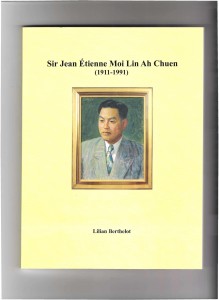Entries from August 2009 ↓
August 20th, 2009 — Entrepreneurship, learning, People, Reflexion
How do you know that you do not know when you do not know?
Thanks to Mind tools I can now share this literature which I was aware of many years back. Excellent tools to use to build up confidence and self esteem.
Creating Better Understanding Between Individuals and Groups
The Johari Window is a communication model that can be used to improve understanding between individuals within a team or in a group setting. Based on disclosure, self-disclosure and feedback, the Johari Window can also be used to improve a group’s relationship with other groups
Developed by Joseph Luft and Harry Ingham (the word “Johari” comes from Joseph Luft and Harry Ingham), there are two key ideas behind the tool:
- That individuals can build trust between themselves by disclosing information about themselves; and
- That they can learn about themselves and come to terms with personal issues with the help of feedback from others.
By explaining the idea of the Johari Window to your team, you can help team members understand the value of self-disclosure, and gently encourage people to give and accept feedback. Done sensitively, this can help people build more-trusting relationships with one another, solve issues and work more effectively as a team.
Explaining the Johari Window:
The Johari Window model consists of a foursquare grid (think of taking a piece of paper and dividing it into four parts by drawing one line down the middle of the paper from top to bottom, and another line through the middle of the paper from side-to-side). This is shown in the diagram below:
Using the Johari model, each person is represented by their own four-quadrant, or four-pane, window. Each of these contains and represents personal information – feelings, motivation – about the person, and shows whether the information is known or not known by themselves or other people.
The four quadrants are:
Quadrant 1: Open Area
What is known by the person about him/herself and is also known by others.
Quadrant 2: Blind Area, or “Blind Spot”
What is unknown by the person about him/herself but which others know. This can be simple information, or can involve deep issues (for example, feelings of inadequacy, incompetence, unworthiness, rejection) which are difficult for individuals to face directly, and yet can be seen by others.
Quadrant 3: Hidden or Avoided Area
What the person knows about him/herself that others do not.
Quadrant 4: Unknown Area
What is unknown by the person about him/herself and is also unknown by others.
The process of enlarging the open quadrant vertically is called self-disclosure, a give and take process between the person and the people he/she interacts with.
As information is shared, the boundary with the hidden quadrant moves downwards. And as other people reciprocate, trust tends to build between them.
|
Tip 1:
Don’t be rash in your self-disclosure. Disclosing harmless items builds trust. However, disclosing information which could damage people’s respect for you can put you in a position of weakness. |
Using the Tool:
The process of enlarging the open quadrant horizontally is one of feedback. Here the individual learns things about him- or her-self that others can see, but he or she can’t.
|
Tip 2:
Be careful in the way you give feedback. Some cultures have a very open and accepting approach to feedback. Others don’t. You can cause incredible offence if you offer personal feedback to someone who’s not used to it. Be sensitive, and start gradually. |
If anyone is interested in learning more about this individual, they reciprocate by disclosing information in their hidden quadrant.
For example, the first participant may disclose that he/she is a runner. The other participant may respond by adding that he/she works out regularly at the local gym, and may then disclose that the gym has recently added an indoor jogging track for winter runners.
As your levels of confidence and self-esteem rises, it is easier to invite others to comment on your blind spots. Obviously, active and empathic listening skills are useful in this exercise.
The Johari Window in a Team Context
Keep in mind that established team members will have larger open areas than new team members. New team members start with smaller open areas because little knowledge about the new team member has yet been shared. The size of the Open Area can be expanded horizontally into the blind space, by seeking and actively listening to feedback from other group members.
Group members should strive to assist a team member in expanding their Open Area by offering constructive feedback. The size of the Open Area can also be expanded vertically downwards into the hidden or avoided space by the sender’s disclosure of information, feelings, etc about himself/herself to the group and group members.
Also, group members can help a person expand their Open Area into the hidden area by asking the sender about himself/herself. Managers and team leaders play a key role here, facilitating feedback and disclosure among group members, and by providing constructive feedback to individuals about their own blind areas.
Key Points:
In most cases, the aim in groups should be to develop the Open Area for every person.
Working in this area with others usually allows for enhanced individual and team effectiveness and productivity. The Open Area is the ‘space’ where good communications and cooperation occur, free from confusion, conflict and misunderstanding.
Self-disclosure is the process by which people expand the Open Area vertically. Feedback is the process by which people expand this area horizontally.
By encouraging healthy self-disclosure and sensitive feedback, you can build a stronger and more effective team.
Feed back
What did I enjoy?
What I learned today?
having experienced today what do I need to change for the next session?
August 19th, 2009 — books, Chinois, Entrepreneurship, People

Lilian Berthelot signe un magnifique livre sur Sir Jean Etienne Moi Lin Ah Chuen. Ce document a été présenté lors une réception la semaine dernière le 12 aout 2009, a l’occasion de la transformation de sa demeure au 5 Rue Révérend Lebrun, Rose-Hill en une maison de souvenir pour sa famille et le public.
Par des interviews des différentes personnes qui ont été proches de Sir Jean E. M. L. Ah Chuen, et par le recueil des photographies et autres documents, Lilian Berthelot retrace la riche carrière de ce grand tribun Mauricien qui a marqué l’histoire de Maurice.
Dès ma jeunesse, je connaissais Sir Jean, car il était un ami de la famille. Par ailleurs les commerces de chaque famille étaient contigües sur la Rue La Reine à Port Louis. Nos familles étaient très proches.
Adolescent je fréquentais la rue Révérend Lebrun et m’y trouvait souvent avec le fils Marc et Vincent pour des escapades du Collège St Mary’s. Leur maison de Rose Hill été un havre pour quelques copains de classe pour notre détente quand nous étions accordés du temps libre. Nous passions des bons moments en écoutant et en fredonnant les chansons de Ricky Nelson jouées sur leur gramophone.
J’etais meme present pour le mariage de son fils aine Raymond au Plaza. Ce mariage dans un sens, etait signe d’une evolution de la mentalite. Mariage d’un Hakka a une Cantonnaise.
Ce document vient encore une fois de plus, enrichir la mémoire et histoire de notre nation.
August 18th, 2009 — books, learning, Reflexion
This was part of my yesterday’s reading, which I found interesting enough to share!
The psychological counseling process follows a defined path of steps in a sequence. It is important to follow this process because of the power of human emotions and because of the real need to arrive at a desired outcome of the counseling.
Listening and Observation
The first step is one of active listening and observing the client. Is he or she relaxed or disturbed and agitated? Can eye contact be held or is the person’s attention darting and being deflected everywhere? Is the body language telling you something? Is the body posture generally open or closed and defensive? (Self protective.)
Facing Negative Emotions
Are there any clearly dominant negative emotions such as anxiety, fear, anger or guilt? These will need to be acknowledged and ‘fed back’ to the client as being observable, real events that need to be dealt with. Unless these negative feelings are actively confronted, no progress can be made with behavior modification and with goal setting. This task of providing feedback on negativity and bringing strong emotions into the light of day may take a considerable amount of time over several one hour sessions. Statements like, ‘I see you are really angry about something’ can be helpful. Also, ‘so you’ve been worrying a lot lately.’
Positive Suggestion and Options
Some suggestions like, ‘you can do something about this,’ may be timely and empowering. Build up the perception of skills and self esteem. ‘You have real ability and you can learn more skills to beat this thing. Deep inside, you can imagine now and think up some solutions.’
‘What are the options facing you?’ leads to a creative brainstorming with the client about how to start moving towards a lasting solution.
Goal Setting
‘So what do you really want?’ becomes the start of finding goals that really follow the interests and desires of the client. The question, ‘what would you need to do first?’ leads to sub goals and tasks that must be fulfilled in order to achieve the primary goal. The counselor’s goal is to draw this information out of the person instead of imposing one’s values and beliefs.
Reinforcement
Systematically rewarding all progress including any ‘baby steps’ taken in the right direction; i.e., towards the agreed upon goals. Reward in this context of counseling means giving the person your focused attention, acceptance, approval and praise. These social rein forcers are very potent in supporting changes in behaviour.
Conclusion
As you are beginning to realize, counselling techniques are not particularly complicated, but they do need to follow a set order or sequence. In fact, psychological counselling may be summarized in two rather direct questions:
1. ‘How are you feeling?’
2. ‘What do you want?’
The psychology here looks at first glance to be oversimplified, but is it really? Results will follow when this sequence is used with the appropriate sensitivity and empathy. Take care with other people and always remember to consult a trained and registered health practitioner when confronting mental health problems of severity, when human life may be at risk. This article is provided for educational purposes only. It is not intended for therapeutic application.
|
Geoff Dodd is a New Zealander with a background in psychology, now living in Western Australia. He has had extensive Internet experience since 1996 and is a webmaster operating 35 web sites.
|
August 17th, 2009 — learning, Toastmasters
Indeed initially I was fearful to address the public. Most of the time I do have some uneasiness before a speech. I believe it is normal. With the training in Toastmasters it has become easier…A leader must possess communications skills to lead!
Are you lacking confidence when it comes to speaking out in public? Does the thought of public speaking grip you with fear? Would you like to eliminate this fear and give confident, successful presentations? Well, direct your focus onto these nine top tips to success and watch those nerves evaporate away.
#1: Deep breathing:
Nerves = Stress = Increased heart rate. 10 minutes before you go on stage, concentrate on your breathing, aiming to take long, deep drawn out breaths. This will slow your heart rate down, and relay messages to your brain that say “Hang-on, I feel okay! I’m not too nervous, this will be fine”. Obviously when you are up on stage however, do not suddenly stop mid-speech to administer your breathing exercises…or your audience may think you’re a few crayons short of a box.
#2: Know your audience wants you to succeed:
Imagine your audience thinking positive thoughts about you as you stand up in front of them. Don’t ever imagine them thinking negatively about you. These negative thoughts will only stand to make you feel even more nervous. If you hold the belief steady in your mind that your audience wants you to be great, your nervousness and fear of public speaking may go away.
#3: Turn your nervousness into excitement:
Frequently, the only difference between the physical sensations we feel when we experience excitement or fear, is just the label we stamp it with. Change this label from fear to excitement and you can turn your nervousness into a positive energy. Getting up on that stage should get you excited and energized!
#4Eat the right foods:
The morning before your presentation, eat a good high protein breakfast. It will keep you going throughout the day, and you’ll have fed your mind and body the proper fuel to work effectively while up on stage.
#5 Visualisation:
Go through the whole presentation in your mind, and visualise it going smoothly and successfully, just how you want it to. When you get up on stage, imagine it has already happened once before, and relax in the knowledge it is going to pan out perfectly. All Olympic athletes use this technique before their events, and it works equally well with public speaking.
#6 Don’t make changes to your material:
NEVER make massive changes to your speech 24 hours before. Re-writing your content at the last minute will only serve to make you feel unprepared and unsettled – cue more nerves. You don’t want to be stuck in a situation where you’re pretty much giving an impromptu talk…
#7. Memorize your opener and close:
These are the bits your audience will remember afterwards. The most important thing they’ll remember is your closing and second most important thing they’ll remember is your opener. Never start with, “Hello” or “Good Morning.” Boring! Start instead with something like a quote or statistic, which relates to your topic. This will immediately grab their attention, and make them think “Hey, this is a bit different!” Two minutes each for an opener and a close is plenty.
#8 Include Variety:
Adding variety into your speech will help prevent you turning into a nervous monotonal wreck. Examples include the addition of humour, quotes, stories, paired and group activities, pauses, audience participation in the question and answer period, and slides or other multimedia. These different factors will not only help you focus on something other than your nerves, but it’ll make your speech a LOT more entertaining.
#9 Imagine a one-one conversation:
Start to take the attitude that you’re speaking one-on-one with different members of the audience. While giving your talk, imagine you are just explaining it to one person at a time. People talking to large groups tend to speak a lot more robotically than they do when speaking to just one or two people. So take this on board and you’ll start to talk in a more natural, personal manner, as you would in a conversation.
Summary:
Feeling confident speaking to a large crowd is within your reach, providing you take action and practice the tips given to you in this article. Don’t give up just because one or two techniques didn’t work for you, everyone’s mind works in different ways. Just try another. Becoming a confident speaker is not just a pipe dream – you learned to feel scared of public speaking somewhere along the line, and you can unlearn it. Use these strategies to start becoming a better you today.
Grace Miller has put together a complimentary report on public speaking that gives special techniques to cure even the worst nerves.
August 16th, 2009 — La fete de 3, Messe, Reflexion
Jn 6,51-58.
Moi, je suis le pain vivant, qui est descendu du ciel : si quelqu’un mange
de ce pain, il vivra éternellement. Le pain que je donnerai, c’est ma
chair, donnée pour que le monde ait la vie. »
Les Juifs discutaient entre eux : « Comment cet homme-là peut-il nous
donner sa chair à manger ? »
Jésus leur dit alors : « Amen, amen, je vous le dis : si vous ne mangez pas
la chair du Fils de l’homme, et si vous ne buvez pas son sang, vous n’aurez
pas la vie en vous.
Celui qui mange ma chair et boit mon sang a la vie éternelle ; et moi, je
le ressusciterai au dernier jour.
En effet, ma chair est la vraie nourriture, et mon sang est la vraie
boisson.
Celui qui mange ma chair et boit mon sang demeure en moi, et moi je demeure
en lui.
De même que le Père, qui est vivant, m’a envoyé, et que moi je vis par le
Père, de même aussi celui qui me mangera vivra par moi.
Tel est le pain qui descend du ciel : il n’est pas comme celui que vos
pères ont mangé. Eux, ils sont morts ; celui qui mange ce pain vivra
éternellement. »
============================================================================
La lecture de ce texte de St Jean m’invoque le mot ‘sublimation’. J’ai tout de suite accouru vers mon Larousse pour lire la définition du mot.
Sublimation : nf. Chim. Passage d’un corps de l’état solide à l’état gazeux. Action d’orienter une tendance, une passion vers un intérêt moral ou une valeur sociale positive. Sublime : adj. Le plus élève, le plus haut, en parlant des choses morales, intellectuelles ou esthétiques.
Je suis convaincu qu’ ainsi que ce pain et de ce vin qui sont le fruit de la transformation de l’homme ; de froment et des raisins sont transformes le pain et le vin; que Si l’homme peut transformer le froment et les raisins en Pain et Vin : Jésus Dieu peut faire encore mieux, n’est ce pas ? Cette offrande des fruits du travail de l’homme devient Corps et Sang de Jésus par cette sublimation que nous opère notre Sauveur venu nous sauver.
En chimie, la sublimation de l’eau en vapeur, requiert de l’énergie. Une fois sublimée cette vapeur possède cette énergie souvent utilisée dans les moteurs à vapeur. Ainsi ce corps et sang transformés en nourriture céleste et éternelle possède cette énergie de Dieu, pour être l’élément moteur de notre vie spirituelle.
Nous te rendrons grâce Seigneur Dieu d’avoir instituer le sacrement de l’Eucharistie pour nous nourrir et nous fortifier. Que la consommation de ton corps me rend en communion avec toi pour les siècles et les siècles. Amen.
August 15th, 2009 — Entrepreneurship, Environment, learning
In the world envisioned by science author Janine Benyus, a locust’s ability to avoid collision within a roiling cloud of its brethren informs the design of a crash-resistant car; a self-cleaning leaf inspires a new kind of paint, one that dries in a pattern that enables simple rainwater to wash away dirt; and organisms capable of living without water open the way for vaccines that maintain potency even without refrigeration — a hurdle that can prevent life-saving drugs from reaching disease-torn communities. Most important, these cool tools from nature pull off their tricks while still managing to preserve the environment that sustains them, a life-or-death lesson that humankind is in need of learning.
As a champion of biomimicry Benyus has become one of the most important voices in a new wave of designers and engineers inspired by nature. Her most recent project, , explores what happens if we think of nature by function and looks at what organisms can teach us about design.
“The sophisticated, almost pro-growth angle of Benyus shows the great potential profitability of copying some of nature’s time-tested, nonpolluting, room-temperature manufacturing and computing technologies.”
New York Times
August 14th, 2009 — La fete de 3, Messe

Demain C’est la fête de la Vierge plus précisément la fête de son élévation au ciel.
L’église catholique a établi sous un dogme par Munificentissimus Deus du pape Pie XII l’Assomption de la Vierge Marie Mère de Jésus.
« Enfin la Vierge immaculée, préservée par Dieu de toute atteinte de la faute originelle, ayant accompli le cours de sa vie terrestre, fut élevée corps et âme à la gloire du ciel, et exaltée par le Seigneur comme la Reine de l’univers, pour être ainsi plus entièrement conforme à son Fils, Seigneur des seigneurs, victorieux du péché et de la mort. »
Cet événement est compris comme les prémices de la résurrection des corps, qui selon la croyance de l’Église orthodoxe, aura lieu lors du Second avènement du Christ, comme l’exprime le théologien Vladimir Lossky : “Si Elle resta encore dans le monde, si Elle se soumit aux conditions de la vie humaine jusqu’à accepter la mort, c’est en vertu de sa volonté parfaite, dans laquelle elle reproduisit la kénose (humiliation) volontaire de son Fils. Mais la mort n’avait plus d’emprise sur Elle : comme son Fils, elle est ressuscitée et montée au Ciel, première hypostase humaine qui réalisa en Elle la fin dernière pour laquelle fut créé le monde.”
Elle est nul doute un personnage choisie parmi toutes les femmes pour être la mère terrestre de notre Sauveur Dieu. Sainte Vierge Marie; Priez pour nous pauvres pecheurs maintenant et a l’heure de notre mort.
Nous nous réjouissons ! Et rendons grâce à Dieu.
August 14th, 2009 — Entrepreneurship, Family stories, learning
Today I learnt of the demise of Les Paul at 94. He has left an extraordinary wealth to the world of Music.

Tinkering with electronics and guitar amplification since his youth, Les Paul began constructing his own electric guitar in the late ’30s. Unhappy with the first generation of commercially available hollowbodies because of their thin tone, lack of sustain, and feedback problems, Paul opted to build an entirely new structure. “I was interested in proving that a vibration-free top was the way to go,” he has said. “I even built a guitar out of a railroad rail to prove it. What I wanted was to amplify pure string vibration, without the resonance of the wood getting involved in the sound.” With the good graces of Epiphone president Epi Stathopoulo, Paul used the Epiphone plant and machinery in 1941 to bring his vision to fruition. He affectionately dubbed the guitar “The Log.”
Les Paul’s tireless experiments sometimes proved to be dangerous, and he nearly electrocuted himself in 1940 during a session in the cellar of his Queens apartment. During the next two years of rehabilitation, Les earned his living producing radio music. Forced to put the Pennsylvanians and the rest of his career on hold, Les Paul moved to Hollywood. During World War II, he was drafted into the Army but permitted to stay in California, where he became a regular player for Armed Forces Radio Service. By 1943 he had assembled a trio that regularly performed live, on the radio, and on V-Discs. In 1944 he entered the jazz spotlight—thanks to his dazzling work filling in for Oscar Moore alongside Nat King Cole, Illinois Jacquet, and other superstars —at the first of the prestigious Jazz at the Philharmonic concerts.
By his mid-thirties, Paul had successfully combined Reinhardt-inspired jazz playing and the western swing and twang of his Rhubarb Red persona into one distinctive, electrifying style. In the Les Paul Trio he translated the dizzying runs and unusual harmonies found on Jazz at the Philharmonic into a slower, subtler, more commercial approach. His novelty instrumentals were tighter, brasher, and punctuated with effects. Overall, the trademark Les Paul sound was razor-sharp, clean-shaven, and divinely smooth.
As small combos eclipsed big bands toward the end of World War II, Les Paul Trio’s popularity grew. They cut records for Decca both alone and behind the likes of Helen Forrest, the Andrews Sisters, the Delta Rhythm Boys, Dick Hayes, and, most notably, Bing Crosby. Since 1945, when the crooner brought them into the studio to back him on a few numbers, the Trio had become regular guests on Crosby’s hit radio show. The highlight of the session was Paul’s first No. 1 hit and million-seller, the gorgeous “It’s Been a Long, Long Time.”
The announcement of his death today made me, relived a fantastic period of my life.
Oh ! my youth, my love of Pop music! My passion for music!
The days with a bunch of friends we got together to play music. The grain of entrepreneurship in me got me to convince my friends, with the help of my father, to start a small band: ‘The Boys’. As the leader of the band it was a learning experience of dealing with a variety of people. Hind sight the germs of leadership skills were starting to sprout.

Today I would like to share with you my past passion of the guitar. I was offered a guitar as a birthday present from my parents. It was a black acoustic guitar bought from Venpin store. With my younger brother we took Guitar lessons from Claudio Cassimally who then was a young musician of the Police Band. He was recommended by the Band master Philip Ohsan who was a close friend of my Dad.

Together with another friend who owned a Framus german acoustic Guitar we started practicing together. As our music and dexterity improved, we got more friends with similar interest to join in our jam sessions. The idea of having a band germinated. The days of the all guitar band started to become fashionable with the advent of the ‘SHADOWS’. I convince my Dad to buy us a set of drums and an electric lead Guitar( Egmond) which was driven by an old Radio set to amplify the sound.

Our friend Dasso joined us with his Tesco Japanese ‘Les Paul’ imitation guitar. I went to shop around for a bass guitar, it was far more that we could afford. Lok Wah another friend whose father was a cabinet maker offered to help us to build a bass guitar from kits we could buy from the music stores. A blue formica electric Bass guitar, (Selmer type) after much work was crafted. Thus we completed our sets of three guitars and drums set. My dream was always to own a VOX, Fender or Gibson sets. It remained a dream…

August 13th, 2009 — Entrepreneurship, learning, People
Have you heard of Micheal Pritchard’s water filter?
Why you should listen to him:
During the twin tragedies of the Asian tsunami and Hurricane Katrina, Ipswich water-treatment expert Michael Pritchard winced helplessly at televised coverage of throngs of refugees waiting for days for a simple drink of clean water. Stricken by the chronic failure of aid agencies to surmount this basic challenge, Pritchard decided to do something about it.
Using a non-chemical nano-filtration hollow fiber membrane with 15 nanometer pores (it is designed to block viruses), the Lifesaver bottle can make the most revolting swamp water drinkable in seconds. Better still, a single long-lasting filter can clean 6,000 liters of water. Given the astronomical cost of shipping water to disaster areas, Pritchard’s Lifesaver bottle could turn traditional aid models on their heads.
“On the outside, it looks like an ordinary sports bottle. On the inside, there’s a miracle: an extremely advanced filtration system that makes murky water filled with deadly viruses and bacteria completely clean in just seconds.”
Allison Barrie, FoxNews.com
He featured on the TED global 2009and I take great pleasure in spreading the ideas.
During the cyclone season it would be handy to have a water filter bottle in store for use to ward of the germs coming in the water system. We yet have to evaluate the landed price of the filters from life saver system in comparison with bottled water.
August 12th, 2009 — books, Family stories, People

Je suis pris depuis ce matin dans l’univers de Robert Tatin.
Qui est-il ?
Robert Tatin tente de jeter un pont entre l’homme et l’homme, de marier le ciel et la terre. Sculpteur, peintre, céramiste, il peuple la vieille ferme de la Frênouse, à Cossé-le-Vivien, de statues polychromes qui figurent son aventure intérieure : c’est le domptage-de-la-bête ; qui illustrent les grands principes vitaux : porte-du-soleil, porte-de-la-lune ; qui dressent un ensemble monumental en l’honneur de tout le monde : c’est Notre-dame-tout-le-monde. Depuis peu, la Frênouse est devenue musée. La place manque ? il prolonge son Å“uvre par un chemin de statues qui rejoint la route et peut-être ira jusqu’à la mer. Ce livre de dessins et poésie tend un nouveau bras. Alain Barré.
Le Jardin des Méditations
Comme la maison de Robert Tatin, l’Å“uvre est orientée est-ouest, la Porte du Soleil au levant et la Porte de la Lune au couchant. Ces dernières encadrent un bassin central en forme de croix d’où émerge Notre-Dame-Tout-le-Monde (6,50 m de haut), qui se dresse vers le ciel étoilé comme la promesse d’un cosmos à notre portée. Les petits personnages sculptés autour du bassin représentent les activités humaines et les grands événements de la nature, propres à chaque mois de l’année. Le visiteur est invité à découvrir ce patio en respectant le sens de rotation de la Terre.
De cet espace intérieur habité d’innombrables personnages à la polychromie éclatante, s’élèvent deux escaliers attirant une nouvelle fois le regard vers le ciel. Autour de l’ensemble, un déambulatoire nous conduit à découvrir les salles d’expositions…
A travers des images pourvus par internet et les sites web j’ai pris plaisir non seulement de connaitre l’homme mais également de puiser à travers des ses œuvres sa pensée. Pas une tarte je dirai !
Je retrouve ici, une parole de ma grand-mère, qui par tradition disait qu’il fallait toujours orienter son lit sur l’axe est-ouest pour bien se reposer. Bien plus tard, j’ai compris que notre corps situant dans cette position été moins exposé aux champs magnétiques de la terre !
C’est bien un voyage en Mayenne que j’ai entrepris aujourd’hui.







